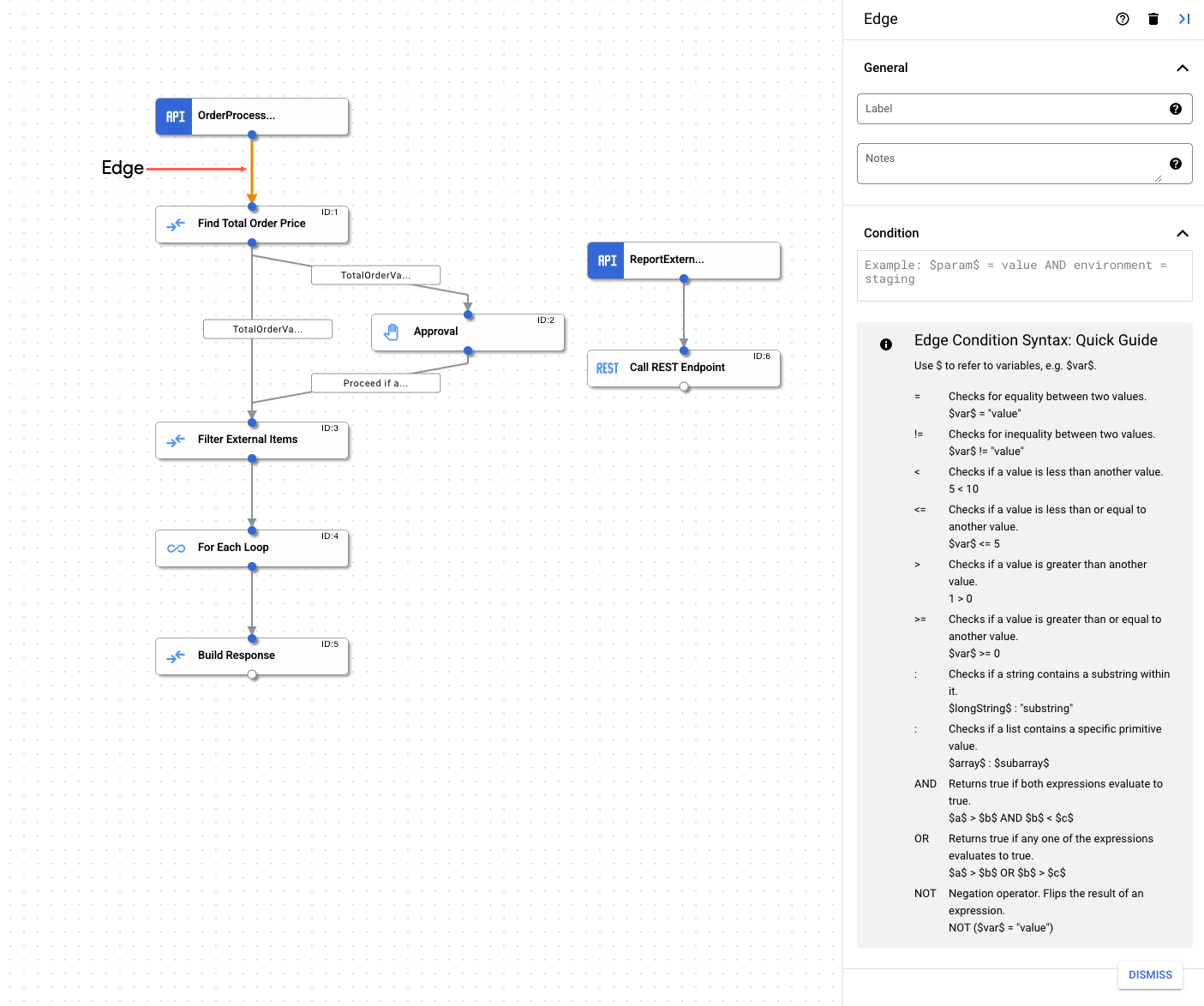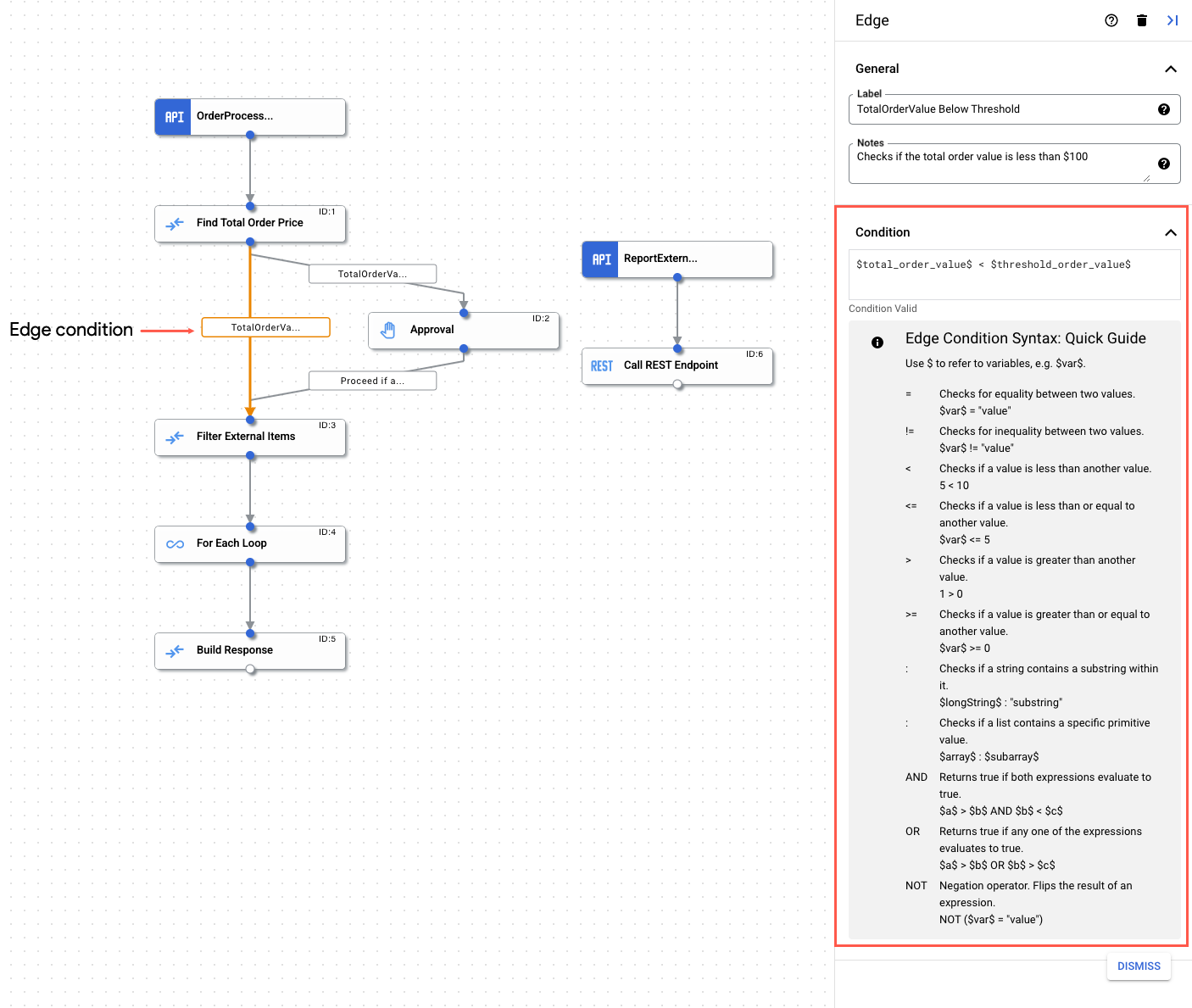Lihat konektor yang didukung untuk Integration Aplikasi.
Kondisi edge dan edge
Edge
Edge adalah koneksi antara dua elemen dalam integrasi. Koneksi menunjukkan arah alur kontrol dari satu elemen(tugas atau pemicu) ke elemen lainnya. Koneksi dapat berupa antara pemicu dan tugas atau antara tugas dan tugas lainnya. Dengan menggunakan edge bersama dengan fork dan join, Anda dapat menerapkan cabang dan kondisi yang kompleks dalam integrasi. Untuk mengetahui informasi selengkapnya, lihat Fork dan join.
Misalnya, jika ada edge dari tugas Kirim Email ke tugas Integrasi Panggilan, artinya setelah tugas Kirim Email dijalankan, tugas berikutnya yang akan dijalankan adalah tugas Integrasi Panggilan. Edge juga mendukung pemeriksaan kondisional. Sebelum kontrol diteruskan ke tugas berikutnya, Anda dapat memeriksa kondisi di tepi dan berdasarkan hasilnya, memutuskan untuk menjalankan tugas atau tidak. Untuk informasi selengkapnya tentang pemeriksaan bersyarat yang didukung, lihat Kondisi Edge.


Kondisi edge
Kondisi edge memungkinkan Anda menentukan kondisi yang harus dipenuhi agar kontrol integrasi diteruskan ke tugas yang terhubung oleh edge. Tugas dijalankan hanya jika kondisi yang ditentukan terpenuhi. Kondisi tepi berguna jika ada beberapa tepi masuk ke tugas, dengan setiap tepi memeriksa kondisi tertentu sebelum tugas.
Tentukan kondisi tepi menggunakan langkah-langkah berikut:
- Di Google Cloud console, buka halaman Application Integration.
- Di menu navigasi, klik Integrations.
Halaman Integrasi akan muncul yang mencantumkan semua integrasi yang tersedia di project Google Cloud.
- Pilih integrasi yang ada atau klik Buat integrasi untuk membuat integrasi baru.
Jika Anda membuat integrasi baru:
- Masukkan nama dan deskripsi di panel Buat Integrasi.
- Pilih region untuk integrasi.
- Pilih akun layanan untuk integrasi. Anda dapat mengubah atau memperbarui detail akun layanan integrasi kapan saja dari panel Ringkasan integrasi di toolbar integrasi.
- Klik Buat. Integrasi yang baru dibuat akan terbuka di editor integrasi.
- Di menu navigasi editor integrasi, klik Tugas untuk melihat daftar tugas dan konektor yang tersedia.
- Pilih integrasi yang ada atau buat integrasi baru.
- Di editor integrasi, klik tepi untuk membuka panel konfigurasi Edge.
- Konfigurasi edge:


Operator yang didukung
Tabel berikut menjelaskan operator yang didukung dan tersedia untuk digunakan dalam kondisi tepi.
| Operator | Deskripsi | Contoh |
| = | Memeriksa kesetaraan antara dua nilai | $var$ = "value" |
| != | Memeriksa ketidaksetaraan antara dua nilai | $var$ != "value" |
| < | Memeriksa apakah nilai kurang dari nilai lain | 5 < 10 |
| <= | Memeriksa apakah nilai kurang dari atau sama dengan nilai lain | $var$ <= 5 |
| > | Memeriksa apakah nilai lebih besar dari nilai lain | 1 > 0 |
| >= | Memeriksa apakah nilai lebih besar dari atau sama dengan nilai lain | $var$ >= 0 |
| : | Memeriksa apakah string berisi substring di dalamnya, atau memeriksa apakah daftar berisi nilai primitif tertentu. |
|
| AND | Memeriksa dua ekspresi dan menampilkan true jika kedua ekspresi dievaluasi sebagai true. | $a$ > $b$ AND $b$ < $c$ |
| ATAU | Memeriksa dua ekspresi dan menampilkan true jika salah satu ekspresi dievaluasi ke true. | $a$ > $b$ OR $b$ < $c$ |
| NOT | Operator negasi. Membalik hasil ekspresi. | NOT($var$ = "value") |
Fungsi yang didukung
Tabel berikut menjelaskan fungsi yang didukung yang tersedia untuk digunakan dalam kondisi tepi.
| Fungsi | Deskripsi |
exists(VARIABLE)
|
Memeriksa apakah variabel tertentu ada |
does_not_exist(VARIABLE)
|
Memeriksa apakah variabel tertentu tidak ada |
is_empty(VARIABLE)
|
Memeriksa apakah variabel tertentu adalah daftar DAN kosong. Mendukung jenis variabel array kecuali array JSON. |
is_not_empty(VARIABLE)
|
Memeriksa apakah variabel tertentu adalah daftar DAN tidak kosong. Mendukung jenis variabel array kecuali array JSON. |
Kuota dan batas
Untuk mengetahui informasi tentang kuota dan batas, lihat Kuota dan batas.
Langkah berikutnya
- Pelajari semua tugas dan pemicu.
- Pelajari cara menguji dan memublikasikan integrasi.
- Pelajari penanganan error.
- Pelajari log eksekusi integrasi.

